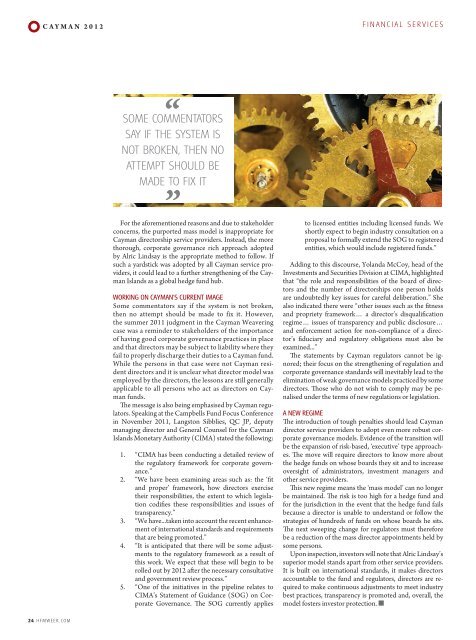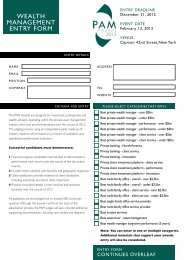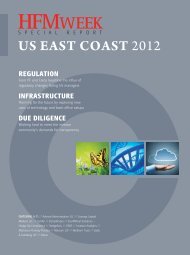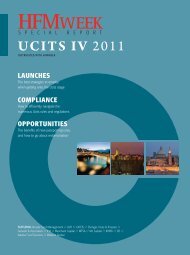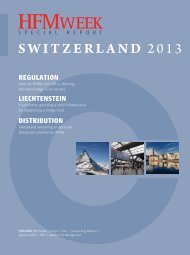CAYMAN 2012 - HFMWeek
CAYMAN 2012 - HFMWeek
CAYMAN 2012 - HFMWeek
- No tags were found...
You also want an ePaper? Increase the reach of your titles
YUMPU automatically turns print PDFs into web optimized ePapers that Google loves.
<strong>CAYMAN</strong> <strong>2012</strong><br />
FINANCIAL SERVICES<br />
SOME COMMENTATORS<br />
SAY IF THE SYSTEM IS<br />
NOT BROKEN, THEN NO<br />
ATTEMPT SHOULD BE<br />
MADE TO FIX IT<br />
”<br />
For the aforementioned reasons and due to stakeholder<br />
concerns, the purported mass model is inappropriate for<br />
Cayman directorship service providers. Instead, the more<br />
thorough, corporate governance rich approach adopted<br />
by Alric Lindsay is the appropriate method to follow. If<br />
such a yardstick was adopted by all Cayman service providers,<br />
it could lead to a further strengthening of the Cayman<br />
Islands as a global hedge fund hub.<br />
WORKING ON <strong>CAYMAN</strong>’S CURRENT IMAGE<br />
Some commentators say if the system is not broken,<br />
then no attempt should be made to fix it. However,<br />
the summer 2011 judgment in the Cayman Weavering<br />
case was a reminder to stakeholders of the importance<br />
of having good corporate governance practices in place<br />
and that directors may be subject to liability where they<br />
fail to properly discharge their duties to a Cayman fund.<br />
While the persons in that case were not Cayman resident<br />
directors and it is unclear what director model was<br />
employed by the directors, the lessons are still generally<br />
applicable to all persons who act as directors on Cayman<br />
funds.<br />
The message is also being emphasised by Cayman regulators.<br />
Speaking at the Campbells Fund Focus Conference<br />
in November 2011, Langston Sibblies, QC JP, deputy<br />
managing director and General Counsel for the Cayman<br />
Islands Monetary Authority (CIMA) stated the following:<br />
1. “CIMA has been conducting a detailed review of<br />
the regulatory framework for corporate governance.”<br />
2. “We have been examining areas such as: the ‘fit<br />
and proper’ framework, how directors exercise<br />
their responsibilities, the extent to which legislation<br />
codifies these responsibilities and issues of<br />
transparency.”<br />
3. “We have...taken into account the recent enhancement<br />
of international standards and requirements<br />
that are being promoted.”<br />
4. “It is anticipated that there will be some adjustments<br />
to the regulatory framework as a result of<br />
this work. We expect that these will begin to be<br />
rolled out by <strong>2012</strong> after the necessary consultative<br />
and government review process.”<br />
5. “One of the initiatives in the pipeline relates to<br />
CIMA’s Statement of Guidance (SOG) on Corporate<br />
Governance. The SOG currently applies<br />
to licensed entities including licensed funds. We<br />
shortly expect to begin industry consultation on a<br />
proposal to formally extend the SOG to registered<br />
entities, which would include registered funds.”<br />
Adding to this discourse, Yolanda McCoy, head of the<br />
Investments and Securities Division at CIMA, highlighted<br />
that “the role and responsibilities of the board of directors<br />
and the number of directorships one person holds<br />
are undoubtedly key issues for careful deliberation.” She<br />
also indicated there were “other issues such as the fitness<br />
and propriety framework… a director’s disqualification<br />
regime… issues of transparency and public disclosure…<br />
and enforcement action for non-compliance of a director’s<br />
fiduciary and regulatory obligations must also be<br />
examined...”<br />
The statements by Cayman regulators cannot be ignored;<br />
their focus on the strengthening of regulation and<br />
corporate governance standards will inevitably lead to the<br />
elimination of weak governance models practiced by some<br />
directors. Those who do not wish to comply may be penalised<br />
under the terms of new regulations or legislation.<br />
A NEW REGIME<br />
The introduction of tough penalties should lead Cayman<br />
director service providers to adopt even more robust corporate<br />
governance models. Evidence of the transition will<br />
be the expansion of risk-based, ‘executive’ type approaches.<br />
The move will require directors to know more about<br />
the hedge funds on whose boards they sit and to increase<br />
oversight of administrators, investment managers and<br />
other service providers.<br />
This new regime means the ‘mass model’ can no longer<br />
be maintained. The risk is too high for a hedge fund and<br />
for the jurisdiction in the event that the hedge fund fails<br />
because a director is unable to understand or follow the<br />
strategies of hundreds of funds on whose boards he sits.<br />
The next sweeping change for regulators must therefore<br />
be a reduction of the mass director appointments held by<br />
some persons.<br />
Upon inspection, investors will note that Alric Lindsay’s<br />
superior model stands apart from other service providers.<br />
It is built on international standards, it makes directors<br />
accountable to the fund and regulators, directors are required<br />
to make continuous adjustments to meet industry<br />
best practices, transparency is promoted and, overall, the<br />
model fosters investor protection. n<br />
24 HFMWEEK.COM


